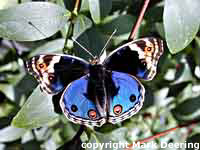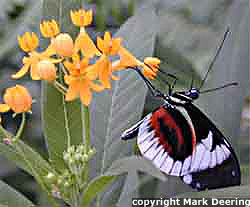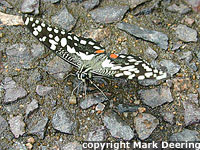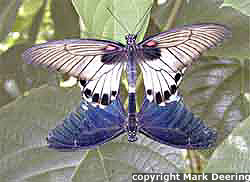Butterfly behaviors
The average adult butterfly lives for only two weeks. As adults, butterflies have two basic jobs: to eat and reproduce. When you visit the Butterfly House, take time to notice what the butterflies are doing.
On the average day at the Butterfly House, you are likely to see our butterflies…
Basking:
 Butterflies are "cold-blooded" which really means that they do not generate enough heat from their own metabolism to provide them with the heat and energy they need to fly. Therefore, butterflies rely on heat absorbed from the sun. You might see butterflies with their wings outstretched sitting in a patch of sunlight. They can raise their internal temperature higher than the temperature around them in a way somewhat analogous to how the interior of a car heats up hotter than the air around it on a sunny day. This need to absorb heat from their environment is the reason why so many butterflies have darkly colored bodies.
Butterflies are "cold-blooded" which really means that they do not generate enough heat from their own metabolism to provide them with the heat and energy they need to fly. Therefore, butterflies rely on heat absorbed from the sun. You might see butterflies with their wings outstretched sitting in a patch of sunlight. They can raise their internal temperature higher than the temperature around them in a way somewhat analogous to how the interior of a car heats up hotter than the air around it on a sunny day. This need to absorb heat from their environment is the reason why so many butterflies have darkly colored bodies.
Nectaring:
 Butterflies do not have any chewing mouthparts. Instead, they eat by sipping liquids, most often nectar, through their proboscis. A butterfly's proboscis can be found curled neatly on the lower side of the head when the butterfly is not eating. When a butterfly does eat, the proboscis is extended through hydrostatic pressure into a relatively straight "straw" which it can then insert into the deep tubes of a flower in order to sip the nectar.
Butterflies do not have any chewing mouthparts. Instead, they eat by sipping liquids, most often nectar, through their proboscis. A butterfly's proboscis can be found curled neatly on the lower side of the head when the butterfly is not eating. When a butterfly does eat, the proboscis is extended through hydrostatic pressure into a relatively straight "straw" which it can then insert into the deep tubes of a flower in order to sip the nectar.
 Some butterflies live in habitats such as rainforest understories, where there is not a constant supply of flowers with nectar for the butterflies to eat. In this case, the butterflies may instead eat the liquids from fermenting fruit found commonly on the forest floor. You may see that our Morphos and Owl butterflies are especially fond of the rotting fruit treats we provide them with at the Butterfly House!
Some butterflies live in habitats such as rainforest understories, where there is not a constant supply of flowers with nectar for the butterflies to eat. In this case, the butterflies may instead eat the liquids from fermenting fruit found commonly on the forest floor. You may see that our Morphos and Owl butterflies are especially fond of the rotting fruit treats we provide them with at the Butterfly House!
Puddling:
 Many male butterflies can be found sipping at the moisture in puddles or wet sand and soil. These butterflies are getting more than water when they sip! They are also benefiting from the salts dissolved in this water. It is thought that these salts help increase a male butterfly's fertility.
Many male butterflies can be found sipping at the moisture in puddles or wet sand and soil. These butterflies are getting more than water when they sip! They are also benefiting from the salts dissolved in this water. It is thought that these salts help increase a male butterfly's fertility.
Mating:
 The butterflies at the Butterfly House do mate. However, because there are no host plants in the flight house for our butterflies to lay their eggs on, you will not find eggs or caterpillars here! Caterpillars are picky eaters, and butterflies are picky egg-layers. A female butterfly will usually choose to never lay her eggs instead of laying them on the wrong plant.
The butterflies at the Butterfly House do mate. However, because there are no host plants in the flight house for our butterflies to lay their eggs on, you will not find eggs or caterpillars here! Caterpillars are picky eaters, and butterflies are picky egg-layers. A female butterfly will usually choose to never lay her eggs instead of laying them on the wrong plant.


